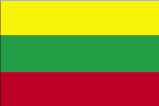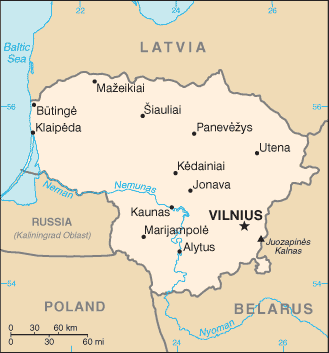|
Lithuania
|

|
Capital: Vilnius
Population: 2,759,627
Brief History of Lithuania:
Lithuania was originally inhabited by Baltic tribes but they were united in 1236 by Mindaugas, the first King of Lithuania. The kingdom of Lithuania grew over the next hundred years and, by the end of the 14th century, was the largest country in Europe. In 1385, Lithuania united with Poland and under King Vytautas the kingdom reached the height of its size and power. The kingdom of Lithuania and Poland lasted until 1795, when it was broken up and divided amongst surrounding countries.
After World War I, Lithuania once again became an independent country, however, it was absorbed by the Soviet Union at the start of World War II. Upon the collapse of the Soviet Union in 1990, Lithuania declared its independence. It became a member of the European Union in 2004.
The Geography of Lithuania
Total Size: 65,200 square km
Size Comparison: slightly larger than West Virginia
Geographical Coordinates: 56 00 N, 24 00 E
World Region or Continent: Europe
General Terrain: lowland, many scattered small lakes, fertile soil
Geographical Low Point: Baltic Sea 0 m
Geographical High Point: Juozapines Kalnas 293.6 m
Climate: transitional, between maritime and continental; wet, moderate winters and summers
Major cities: VILNIUS (capital) 546,000 (2009), Kaunas
The People of Lithuania
Type of Government: parliamentary democracy
Languages Spoken: Lithuanian (official) 82%, Russian 8%, Polish 5.6%, other and unspecified 4.4% (2001 census)
Independence: 11 March 1990 (independence declared from Soviet Union); 6 September 1991 (Soviet Union recognizes Lithuania's independence)
National Holiday: Independence Day, 16 February (1918); note - 16 February 1918 is the date Lithuania declared its independence from Soviet Russia and established its statehood; 11 March 1990 is the date it declared its independence from the Soviet Union
Nationality: Lithuanian(s)
Religions: Roman Catholic 79%, Russian Orthodox 4.1%, Protestant (including Lutheran and Evangelical Christian Baptist) 1.9%, other or unspecified 5.5%, none 9.5% (2001 census)
National Symbol: mounted knight known as Vytis (the Chaser)
National Anthem or Song: Tautiska giesme (The National Song)
Economy of Lithuania
Major Industries: metal-cutting machine tools, electric motors, television sets, refrigerators and freezers, petroleum refining, shipbuilding (small ships), furniture making, textiles, food processing, fertilizers, agricultural machinery, optical equipment, electronic components, computers, amber jewelry
Agricultural Products: grain, potatoes, sugar beets, flax, vegetables; beef, milk, eggs; fish
Natural Resources: peat, arable land, amber
Major Exports: mineral products 23%, textiles and clothing 16%, machinery and equipment 11%, chemicals 6%, wood and wood products 5%, foodstuffs 5% (2001)
Major Imports: mineral products, machinery and equipment, transport equipment, chemicals, textiles and clothing, metals
Currency: litas (LTL)
National GDP: $61,600,000,000
** Source for population (2012 est.) and GDP (2011 est.) is CIA World Factbook.
Back to Geography Home Page
